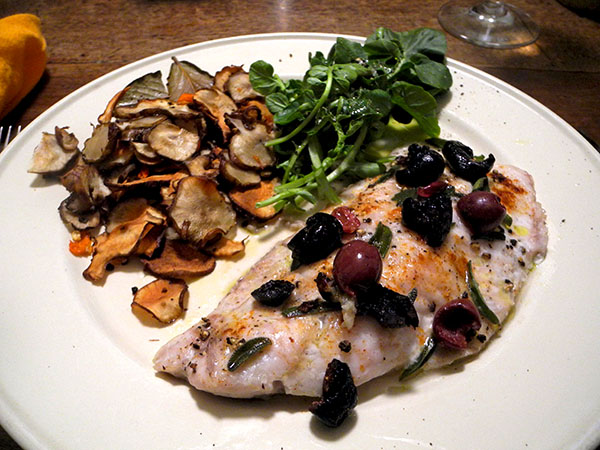
The tautog, or blackfish, is one of my favorites, and it has a close association with one of my favorite places in all the world, the State of Rhode Island and Providence Plantations.
This is the treatment I use most often for this noble fish.
Tonight it was also one of the most successful.
- * two 8-ounce filets of Blackfish/Tautog from Blue Moon Fish, prepared mostly as described in this recipe by Melissa Clark, laying the fish skin side down according to the instructions, and kept it there (although, perversely, the recipe’s image seems to suggest it should be cooked with the skin up); also, necessarily in these sad times; I had to substitute a mix of Nigerian cayenne pepper and Spanish paprika (picante) for the ‘Aleppo Syrian red pepper’ the recipe specified; and then to be specific about the other ingredients I used, the fresh sage was from Phillips Farm; the olives were a mix of black oil-cured ‘Moroccan’ and Gaeta, both from Buon Italia, and the lemon juice was squeezed from a Whole Foods Market organic fruit
- * a bit of sweet upland cress from Paffenroth Gardens, dressed with a drizzle of a good Puglian olive oil, Alce Nero DOP ‘Terra di Bari Bitonto’ from Eataly, Maldon salt, and freshly-ground black pepper
- * twelve or so ounces of sun chokes from Max Creek Hatchery, trimmed, scrubbed, sliced very thinly (1/8-1/4 inch), tossed with barely a tablespoon of olive oil (I think the small amount is somewhat critical to ensuring maximum crispiness), sea salt, freshly-ground black pepper, one fresh chopped habanada pepper, two halved bay leaves from Westside Market, then spread in one layer onto 2 large Pampered Chef unglazed ceramic pans (a single one wasn’t enough, since they had been cut so thinly and they really should show a lot of surrounding surface to become crisp), roasted at 425º for about 30 minutes, or until they were brown, tender, and crispy on the edges
- the wine was a California (Napa) white, Scott Peterson S.P. Drummer Napa Chardonnay 2016, from Naked Wines
- * the music was Luigi Rossi’s ‘Orfeo’, with the Choir and Orchestra of Les Arts Florissants, in a performance which, more than any I had ever before experienced, told me what a brilliant artist can do to raise a great work of art from the sleep to which it might otherwise might have remained condemned forever (the opera’s 1647 premier in Paris was a triumph, but the composer’s history in France was abbreviated by the full-scale rebellion of the Fronde; Rossi returned to Italy and never wrote another theater piece)